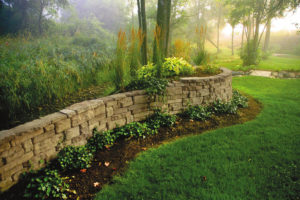Pavers Add Beauty And Functionality To Residential Landscaping
March 4, 2020Seven Advantages Of Installing An Outdoor Water Feature
March 4, 2020 If you own a home, installing retaining walls can provide much-needed protection in sloped outdoor areas while also increasing your property’s resale value. Keep in mind, however, that these benefits are only available if the retaining wall is professionally-designed and correctly installed. Retaining walls play an important role in creating safe, attractive outdoor spaces for homes that have sloping yards or that are located near hills. Working with a qualified landscape contractor is the best way to ensure that your retaining walls function correctly and are installed the right way.
If you own a home, installing retaining walls can provide much-needed protection in sloped outdoor areas while also increasing your property’s resale value. Keep in mind, however, that these benefits are only available if the retaining wall is professionally-designed and correctly installed. Retaining walls play an important role in creating safe, attractive outdoor spaces for homes that have sloping yards or that are located near hills. Working with a qualified landscape contractor is the best way to ensure that your retaining walls function correctly and are installed the right way.
Some of the primary benefits of retaining walls are highlighted below:
1. They Transform Slopes Into Flat Spaces
If your yard slopes, you can use retaining walls to create flat spaces. Although walls like these are sometimes used in areas that are already flat, they are more commonly reserved for areas where the ground slopes or where there are drainage problems. Once a retaining wall is installed, problems like erosion and flooding are far less likely to occur.
2. They Can Make Your Outdoor Space More Attractive
Hardscaping involves using features like walkways, patios, and other structural elements in your outdoor space to add visual interest and to make the space more usable. Along with serving a practical purpose, retaining walls can also add beauty and structure to your yard or garden.
3. They Provide Better Control Over Runoff
Runoff from rainwater can cause erosion and can damage your plants. Retaining walls can be used to slow down the water and to control where it flows. Walls like these are extremely beneficial when it comes to managing runoff, making them a great choice for areas that get a lot of rain.
4. Plenty Of Design Choices
Walls like these come in many different styles. Some of the most popular options include:
– Gravity walls. These walls start out thick at the bottom and become narrower toward the top. They are designed to lean up against whatever material is being retained.
– Cantilever walls. With these walls, the thickness remains the same from the bottom to the top of the wall. The base of the wall is attached to a concrete slab. The wall itself is held in place with steel reinforcements. These reinforcements not only run through the wall but also down into the slab. This helps the wall and the slab function together as a single unit. With retaining walls like these, the base needs to be correctly designed so that it doesn’t succumb to pressure from the surrounding soil.
– Sheet pile walls. With walls like these, planks are placed in the soil with supports on either side. A variety of different types of planks can be used, ranging from vinyl or steel to wood. Walls like these are also sometimes anchored by cables. If you are going to install a sheet pile wall, consider hiring a professional landscaper. They can verify that the wall is strong enough to hold back the soil. Sheet pile walls are commonly used with soft, loose soil.
– Anchored walls. Walls like these rely on cables to provide additional strength. The design is a lot like a sheet pile wall. Cables are attached to the top and base of the wall. They are then anchored into the ground.
– Buttress or counterfort walls. On the backside of these walls, special concrete webs that run vertically are installed. These webs help connect the slab and base of the wall. This minimizes shearing forces and reduces the likelihood of bending as a result of pressure from the soil.
5. They Are Simple To Maintain
Retaining walls are almost always constructed out of low-maintenance materials such as stone or concrete. In situations where wood is used to construct the retaining wall, the wood is treated to help it do a better job of resisting moisture.
Working with a professional landscaping company is the best way to keep your yard looking great all year long. Give us a call today.

1 Comment
[…] most cases, a retaining wall will be constructed from stone blocks. Once your retaining walls are installed, they’ll remain in place for a very long time. You’ll be able to rely on these sturdy […]